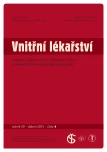Perindopril in the treatment of hypertension and cardiovascular diseases: evolution continues with the orodispersible dosage form
Authors:
J. Václavík
Authors‘ workplace:
I. interní klinika – kardiologická Lékařské fakulty UP a FN Olomouc, přednosta doc. MU Dr. Miloš Táborský, CSc., FESC, MBA
Published in:
Vnitř Lék 2013; 59(4): 290-294
Category:
Review
Overview
Perindopril is a long acting ACE inhibitor with a 24- hour lasting effect. Its positive effect on a reduction in cardiovascular events has been confirmed in a range of large randomized clinical trials and in a wide spectrum of patients: hypertonic patients, diabetics, patients with stable ischaemic heart disease, elderly patients, or patients who have undergone a cerebrovascular accident. The extending range of various fixed combinations as well as new pharmaceutical dosage forms, including the newly introduced orodispersible tablets of perindopril, enables optimization of treatment for every patient, an increase in the patient‘s treatment adherence, and also improvement in long‑term blood pressure control with a consequent effect on reduction of morbidity and mortality.
Key words:
hypertension – cardiovascular disease – treatment – perindopril – pharmaceutical dosage forms – orodispersible tablets
Sources
1. Sica DA. Angiotensin‑Converting Enzyme Inhibitors. In: Black HR, Elliott WJ Hypertension. A Companion to Braunwald‘s Heart Disease. Philadelphia: Saunders 2007, 239 s.
2. Hradec J, Bultas J, Želízko M. Stabilní angina pectoris. Doporučený diagnostický a léčbný postup České kardiologické společnosti. Cor Vasa 2010; 52: 543– 561.
3. Ferrari R, Pasanisi G, Notarstefano P et al. Specific properties and effect of perindopril in controlling the renin‑angiotensin system. Am J Hypertens 2005; 18: 142S– 154S.
4. Filipovský J, Widimský jr. J, Ceral J et al. Diagnostické a léčebné postupy u arteriální hypertenze – verze 2012. Doporučení České společnosti pro hypertenzi. Vnitř Lék 2012; 58: 785– 801.
5. Dahlöf B, Sever PS, Poulter NE et al. Prevention of cardiovascular events with an antihypertensive regimen of amlodipine adding perindopril as required versus atenolol adding bendroflumethiazide as required, in the Anglo- Scandinavian Cardiac Outcomes Trial- Blood Pressure Lowering Arm (ASCOT- BPLA). Lancet 2005; 366: 895– 906.
6. Williams B, Lacy PS, Thom SM et al. Differential impact of blood pressure‑lowering drugs on central aortic pressure and clinical outcomes: principal results of the Conduit Artery Function Evaluation (CAFE) study. Circulation 2006; 113: 1213– 1225.
7. Rothwell PM, Howard SC, Dolan E et al. Effects of beta blockers and calcium-channel blockers on within‑individual variability in blood pressure and risk of stroke. Lancet Neurol 2010; 9: 469– 480.
8. Rothwell PM, Howard SC, Dolan E et al. Prognostic significance of visit– to– visit variability, maximum systolic blood pressure, and episodic hypertension. Lancet 2010; 375: 895– 905.
9. van Vark LC, Bertrand M, Akkerhuis KM et al. Angiotensin‑converting enzyme inhibitors reduce mortality in hypertension: a meta‑analysis of randomized clinical trials of renin‑angiotensin‑aldosterone system inhibitors involving 158,998 patients. Eur Heart J 2012; 33: 2088– 2097.
10. ADVANCE Collaborative Group. Effects of a fixed combination of perindopril and indapamide on macrovascular and microvascular outcomes in patients with Type 2 dibetes mellitus (the ADVANCE trial): a randomised controlled trial. Lancet 2007; 370: 829– 840.
11. Messerli FH, Makani H, Benjo A et al. Antihypertensive efficacy of hydrochlorothiazide as evaluated by ABPM: meta‑analysis of randomized trials. J Am Coll Cardiol 2011; 57: 590– 600.
12. Fox KM The EURopean trial On reduction of cardiac events with Perindopril in stable coronary Artery disease Investigators. Efficacy of perindopril in reduction of cardiovascular events among patients with stable coronary artery disease: randomised, double blind, placebo- controlled, multicentre trial (the EUROPA study). Lancet 2003; 362: 782– 788.
13. Dagenais GR, Pogue J, Fox K et al. Angiotensin‑converting‑enzyme inhibitors in stable vascular disease without left ventricular systolic dysfunction or heart failure: a combined analysis of three trials. Lancet 2006; 368: 581– 588.
14. PROGRESS Collaborative Group. Randomised trial of a perindopril‑based blood– pressure‑lowering regimen among 6 105 patients with prior stroke or transient ischaemic attack. Lancet 2001; 358: 1033– 1041.
15. Beckett NS, Peters R, Fletcher AE et al for the HYVET Study Group. Treatment of hypertension in patients 80 years of age or older. N Engl J Med 2008; 358: 1887– 1898.
16. Remko M, Remková A. Perindopril arginin: nová sůl inhibitoru ACE perindoprilu a její přínos. Remedia 2007; 17: 421– 424.
17. Telejko E. Perindopril arginine: benefits of a new salt of the ACE inhibitor perindopril. Curr Med Res Opin 2007; 23: 953– 960.
18. Václavík J. Hypertonik v ordinaci praktického lékaře. Med pro praxi 2012; 9: 262– 264.
19. Zkrácená informace o přípravku Prestarium®NEO/ NEO FORTE ORODISPERZNÍ TABLETY.
20. Registration file for Prestarium Neo Orodispersible.
21. Lewis DK, Robinson J, Wilkinson E. Factors involved in deciding to start preventive treatment: qualitative study of clinicians‘ and lay people‘s attitudes. BMJ 2003; 327: 841.
Labels
Diabetology Endocrinology Internal medicineArticle was published in
Internal Medicine

2013 Issue 4
Most read in this issue
- Aortic stenosis
- Lung metastases as the first manifestations of occult medullary microcarcinoma
- The „Short Physical Performance Battery“ in the Czech Republic – the pilot and validation study in older persons
- Perindopril in the treatment of hypertension and cardiovascular diseases: evolution continues with the orodispersible dosage form
